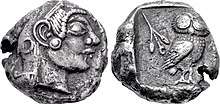Pushkalavati
|
The remains of Pushkalavati's Bala Hisar | |
 Shown within Pakistan | |
| Location |
Outskirts of Charsadda Khyber Pakhtunkhwa Pakistan |
|---|---|
| Coordinates | 34°10′05″N 71°44′10″E / 34.168°N 71.736°ECoordinates: 34°10′05″N 71°44′10″E / 34.168°N 71.736°E |
| Type | Ancient capital city |
| History | |
| Founded | 2nd millennium BCE |
| Periods | Gandhara |
| Site notes | |
| Excavation dates | 1902 |
| Archaeologists |
Sir John Marshall Sir Mortimer Wheeler |
Pushkalavati (Pashto and Urdu: پُشْكَلآوَتي; Sanskrit: पुष्कलावती, IAST: Puṣkalāvatī) was the capital of the Gandhara kingdom.[1] Its ruins are located on the outskirts of the modern city of Charsadda, in the Khyber Pakhtunkhwa province of Pakistan. Its ruins are located on the banks of Swat River, near its junction with Kabul River. Pushkalavati was the capital of the ancient Gandhara kingdom before the 6th century BCE, when it became an Achaemenid regional capital, and it remained an important city until the 2nd century CE.
The region around ancient Pushkulavati was recorded in the Zoroastrian Zend Avesta as Vaēkərəta, or the seventh most beautiful place on earth created by Ahura Mazda. It was known as the "crown jewel" of Bactria, and held sway over nearby ancient Taxila'.[2]
Etymology
Pushkalavati (Sanskrit: पुष्कलावती, IAST: Puṣkalāvatī) means Lotus City in Sanskrit. According to the Ramayana, it was named Pushkalavati because it was founded by Pushkala, the son of Bharat (and hence nephew of Hindu deity Rama).
Ruins
The ruins of Pushkalavati consist of many stupas and the sites of two ancient cities.
Bala Hisar
Bala Hisar site in this area was first occupied in the 2nd millennium BCE.[3][4]
In later 6th century BCE, Pushkalavati became the capital of the Achaemenid Gandhara satrapy.[5] The location was first excavated in 1902 by the archaeologist John Marshall. Sir Mortimer Wheeler conducted some excavations there in 1962, and identified various Achaemenid remains.
Later in the regions historical chronology, King Ashoka built a stupa there which was described by Xuanzang when he visited in 630 CE, which to this day remains unidentified and undiscovered.
Peucela and Shaikhan Dheri
The Bactrian Greeks built a new city (Peucela or Peucelaitis) at this site which lies one kilometre from Bala Hissar on the other side of the branch of River Jinde. This city was occupied by Parthian, Sakas and Kushans and subsequently became known as Shaikhan Dheri (AKA Shaikhn Dher, etc.). In the 2nd century CE, river changed its course and city was flooded. The town moved to the site of the modern village of Rajjar.
The former city's ruins were partly excavated by Ahmad Hasan Dani in 1960s. There are still many mounds at Mir Ziarat, at Rajar and Shahr-i-Napursan which are still unexcavated.
 Buddhist statuary.
Buddhist statuary. Buddhist statues.
Buddhist statues.
Pushkalavati and Prang

The city of Pushkalavati was situated at the confluence of Swat and Kabul rivers. Three different branches of Kabul river meet there. That specific place is still called Prang and considered sacred. A grand graveyard is situated to the north of Prang where the local people bring their dead for burial. This graveyard is considered to be among the largest graveyards in the world.
Pushkalavati in the Ramayana
In the concluding portion of the (Ramayana) Uttarakhanda or Supplemental Book (chaps. 101, 113-41, 200), the descendants of Rama and his brothers are described as the founders of the great cities and kingdoms which flourished in Western India.[8]
Bharata the brother of Rama had two sons, Taksha and Pushkala. The former founded Taksha-sila or Taxila, to the east of the Indus, and known to Alexander and the Greeks as Taxila. The latter founded Pushkala-vati or Pushkalavati, to the west of the Indus, and known to Alexander and the Greeks as Peukelaotis. Thus the sons of Bharat are said to have founded kingdoms which flourished on either side of the Indus river. [9]
See also
References
- ↑ Sagar, Krishna Chandra (1992). Foreign Influence on Ancient India. Northern Book Centre. ISBN 9788172110284.
- ↑ Encyclopædia Britannica: Gandhara Archived 29 September 2007 at the Wayback Machine.
- ↑ Investigating ancient Pushkalavati Pushkalavati Archaeological Research Project
- ↑ Ali et al. 1998: 6–14; Young 2003: 37–40; Coningham 2004: 9.
- ↑ Rafi U. Samad, The Grandeur of Gandhara: The Ancient Buddhist Civilization of the Swat, Peshawar, Kabul and Indus Valleys. Algora Publishing, 2011, p. 32 ISBN 0875868592
- 1 2 "CNG: Printed Auction Triton XV. ATTICA, Athens. Circa 500/490-485/0 BC. AR Tetradrachm (21mm, 16.75 g, 11h)". www.cngcoins.com.
- ↑ "CNG: Printed Auction Triton XV. INDIA, Pre-Mauryan (Gandhara). Period of Achaemenid Rule. Circa 5th century BC. Cast AR Cake Ingot". www.cngcoins.com.
- ↑ Gandhara and Its Art Tradition, Ajit Ghose, Mahua Publishing Company, 1978, p. 14
- ↑ Dwaraka Prasad Sharma. "Shrimad Valmiki Ramayan - Sanskrit Text with Hindi Translation- DP Sharma 10 volumes" – via Internet Archive.
External links
- Investigating ancient Pushkalavati Pushkalavati Archaeological Research Project
- Map of Gandhara archaeological sites, from the Huntington Collection, Ohio State University (large file)
._Period_of_Achaemenid_Rule._Circa_5th_century_BCE.jpg)